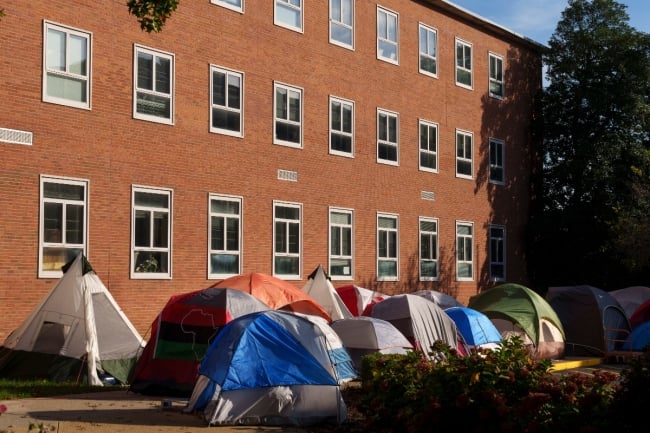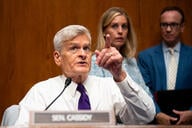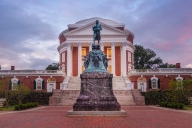You have /5 articles left.
Sign up for a free account or log in.

Over the 34-day protest, students pitched tents outside and slept inside the Blackburn Student Center.
Drew Angerer/Getty Images
The monthlong student protest at Howard University over housing and representation, which led students and alumni at other historically Black institutions to protest in solidarity, ended Monday morning after the demonstrators reached an agreement with the administration.
In a livestream, Howard student demonstrators and their attorney, Donald Temple, celebrated the agreement, the details of which remained private.
“It can be said without any hesitation or reservation that the students courageously journeyed on a path towards greater university accountability and transparency and public safety,” Temple said during the livestream. “And this agreement marks a meeting of minds between the issues of concern.”
Howard senior Aniyah Vines, founder of the Live Movement, a community organization bringing awareness to issues at Howard, said the agreement promised increased transparency and accountability.
“We spent 33 days challenging our university administration,” Vines said. “We came, we saw, we declared and we won. We won for our students. We won for Howard University, both historic Howard and the future Howard, and we won for our community.”
Howard president Wayne A. I. Frederick said in a statement released Monday evening that the university will share details of the agreement “soon” and that student protesters agreed to leave the Blackburn Student Center. He said he expects nonstudent protesters to depart the surrounding area as well.
“This is a welcome step forward as we continue to bring together our Howard community,” Frederick wrote.
Student demonstrators, including those from the Young Democratic Socialists of America and the Live Movement, first occupied Howard’s Armour J. Blackburn University Center on Oct. 12 to protest lack of representation on the university’s Board of Trustees and substandard housing conditions, including mold in some dorm rooms and rats and roaches in the Blackburn Café, a resident dining establishment.
Concerns about mold were amplified Friday when the fourth floor of College Hall South, a student residence hall, flooded. The university told WTOP News that a restoration contractor was drying the walls and checking for moisture in the affected areas. The university also vowed to assist students displaced by the flooding or whose personal belongings were damaged. The Live Movement posted videos of the flooded dorm rooms, writing that students had to evacuate in the middle of the night.
“The health and well-being of our students is the most important part of my job as president,” Frederick wrote in Monday’s statement. “As I have said before, even one issue in one of our dormitories is too many, and we will continue to remain vigilant in our pledge to maintain safe and high-end housing.”
He wrote that solutions to concerns raised by students will be addressed through the Howard Forward strategic plan, which aims to enhance academic excellence and achieve financial sustainability, and the university’s 2020 campus master plan, which includes new buildings on the campus.
“As we close in on the Thanksgiving holiday, I am encouraged and excited about the work we have accomplished—and the work we will continue to do—together to reinforce Howard University,” Frederick wrote in the statement.
From the beginning, the student demonstrators demanded three action items: an in-person town hall with Frederick; the reinstatement of affiliate Board of Trustee positions—with voting power—for students, faculty and alumni; and the creation of a proposed housing plan “to protect the incoming classes of Howard’s immediate future.” Since the protest started, students have also demanded legal, disciplinary and academic immunity for protesters.
During the protest, students pitched tents outside and slept inside the Blackburn Student Center, which prompted Frederick to write an open letter calling on the sit-in to end.
Since the protest started, the university has had to relocate a coronavirus testing site from the Blackburn Student Center to a library, a university spokesperson told The Washington Post. The cafeteria in the Blackburn Student Center was closed because of the protest, Frederick wrote in a campus update Nov. 2, which resulted in the university’s food partner Sodexo laying off some of its workers.
“People who work hard to serve our campus are hurting,” Frederick wrote. “Students have not been able to fully use their meal plans over the last three weeks and enjoy a space recently renovated for all our students. These issues should concern us all.”
The protest by Howard students sparked a protest at the Atlanta University Center, where students from Clark Atlanta University, Morehouse College, Morris Brown College and Spelman College demanded the presidents of their institutions meet with student leaders to fully assess campus housing needs and quality of life. Students said they were protesting in solidarity with Howard.
Many Howard alumni came out in support of the students. The alumni group Howard Alumni United started a petition to reinstate full representation for alumni, students and faculty on Howard’s Board of Trustees.
“On principle, Howard Alumni United (HAU) stands in solidarity with the students who are peacefully occupying the Blackburn Student Center and will support them with their requested resources and supplies,” the organization wrote in a statement. “We also strongly encourage other Howard University alumni, as well as friends and supporters of the University, to do the same.”
Some politicians joined in supporting the student protesters. Ras Baraka, the mayor of Newark, N.J., and a Howard graduate, said protesting was part of his education and a tradition at Howard. He participated in the 1989 protest at Howard, in which students demanded improvements in financial aid programs and campus buildings and insisted that Lee Atwater, the Republican Party national chairman, resign from the Board of Trustees.
“The purpose of this protest is to win something,” Baraka said during a rally Saturday organized by Howard alumni. “Material conditions have to change.”
The Reverend Jesse Jackson joined the demonstrators on campus in late October. “Never surrender,” he told students. “Keep hope alive.” The civil rights leader was later hospitalized after he fell on campus and hit his head.
As for the Live Movement, they say they’re just getting started advocating for better housing conditions and accountability, not just at Howard but at all HBCUs.
“A precedent has been set for the generations to come,” the organization wrote on Instagram. “There is administration at HBCUs across the nation that need to be held accountable, and we will make sure that the students have a platform to not only voice their truth but get their demands met by any means necessary.”




